

Introduction: Audit, Plan and IPL
Good morning ladies and gentlemen. It is a pleasure to be here in Melbourne today for the Ports Australia Centennial Conference. And congratulations on the first 100 years.
I would like to thank David Anderson and Ports Australia for inviting me to take part in what has already been a great opportunity to hear from some of the nation's leaders in transport and logistics.
For those who are not familiar with what we do, Infrastructure Australia is an independent advisor to Australian governments and the community on the reforms and projects needed to meet the challenges of the future.
We publically advocate for reforms on key issues including financing, delivering and operating infrastructure and how to better plan and utilise Australia's infrastructure networks.
Over the past 18 months we have been busy delivering three landmark reports:
- The Australian Infrastructure Audit—a comprehensive review of the current state of Australia's infrastructure and an evidence base for our future needs across transport, water, energy and telecommunications.
- The Australian Infrastructure Plan—Launched in Brisbane with the Prime Minister back in February, this is a reform based document, responding to the audit, which provides a road map for governments, business and the community to address Australia's infrastructure challenges—and
- The Infrastructure Priority List—which sits alongside the Plan and provides a prioritised list of nationally-significant investments and guidance to decision makers on where they should direct funding.
The Infrastructure Priority List has kept us particularly busy in recent months.
This year, the Infrastructure Australia Board has assessed a record number of business cases for priority and high priority projects.
And I am pleased to report that proponents are increasingly recognising the importance of aligning project proposals with an identified infrastructure need.
With a strong pipeline of business cases continuing to be received and assessed in coming months, we are working hard to support better infrastructure decision-making and delivery.
For my presentation this morning I want to focus on the findings of the Australian Infrastructure Audit with particular reference as to how we can plan to meet the increasing demand for Australia's ports.
I also want talk in greater detail about some of the key recommendations in our 15-year Australian Infrastructure Plan.
In particular, I want to discuss our proposal for a National Freight and Supply Chain Strategy and explain why it would support the development of a fairer and more sustainable system of funding the landside infrastructure our ports rely on.

Strategic long-term infrastructure planning
The 2015 Australian Infrastructure Audit identified the challenges that our infrastructure faces out to 2031 and for the first time provided an evidence base for a long-term Infrastructure Plan.
The Audit found that as a nation, we have been slow to secure the improvements in efficiency and service delivery that come from long-term, strategic infrastructure planning.
It found that Australia needs to integrate infrastructure and land-use planning across all levels of government if we are to meet the challenges of the future.
Of course, long-term planning necessarily involves dealing with uncertainty and given the recent structural shifts in our economy, planning for our future infrastructure needs is as challenging as ever.
In recent years, we have seen a downturn in mining and heavy industry construction.
We have also seen a prolonged weakness in commodity prices, which affects future resources investment and government revenues available to fund new infrastructure.
With the end of the mining boom, our economy is undergoing a challenging and protracted structural shift as we look to rebuild dollar-exposed industries and non-mining investment.
We are also preparing for significant population growth, particularly in our major cities.

Growth in Australia's capital cities
The Audit identified that Australia's population will grow to more than 30 million people by 2031, with the population of Australia's four largest cities—Sydney, Melbourne, Brisbane and Perth—increasing by close to 50 per cent.
Growth like this provides a larger domestic market for businesses and increases the size of the labour force, but it also puts additional pressure on existing infrastructure already subject to high levels of demand.
If we don't adequately plan for this significant rise in demand for infrastructure services, Australia could face a future of congestion and constraint.
Increasing bottlenecks and delays will mean it takes longer for Australians to get to work or home, our goods will take longer to reach ports and markets, and the many services we rely on from infrastructure will decline.
And the impact of this congestion on the economy would be significant.
Without investment and reform to increase capacity and better manage demand, the annual cost of congestion in our capital cities could exceed $53 billion by 2031.

Growth in Asia's middle class
In addition to Australia's population growth, another important factor in planning for our future infrastructure needs is our close proximity to the booming economies of China and South-East Asia.
Asia will account for around two-thirds of the world's middle class population by 2031.
As one of the few English language nations in the Asia Pacific, Australia is well-placed to take advantage of this population growth and the associated shift in global power.
Our proximity to Asia, and the quality of our exports and skills, therefore has the potential to be a strong driver of economic growth in Australia.
It follows then, Australia's port and freight infrastructure will play a central role in continuing our national economic success story, and this is reflected in the demand forecasts for containerised and non-containerised trade.
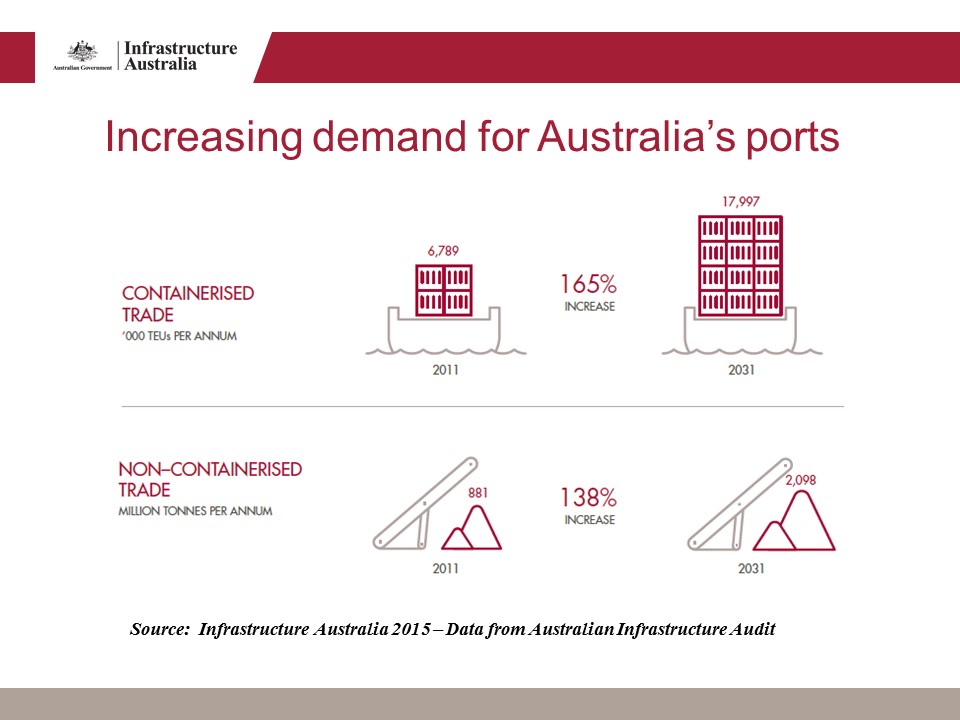
Increasing demand for Australia's ports
The Audit found that the number of containers moving through Australia's ports will grow by over 5 per cent each year until 2031.
With non-containerised trade, the annual growth rate is expected to be around 4 per cent.
Demand for both is projected to grow faster than GDP.
So how do we as a nation plan for this future increase in demand and an increase in ship sizes?
Expanding port facilities obviously involves long lead-in times and requires careful consideration to manage environmental issues and improve supporting landside connections.
That's why the Infrastructure Priority List includes a range of investments that have the potential to improve rail access to our ports, such as Inland Rail, the Port Botany freight rail duplication and freight rail access to Port Kembla and the Port of Brisbane.
But planning for this projected increase in demand means we also need to recognise the importance of maintaining effective maritime channels to the ports.
And of course in addition to the infrastructure itself, we also need to have the supply chains—the ‘systems and human’ elements—the jobs and communities in place to make it all work.
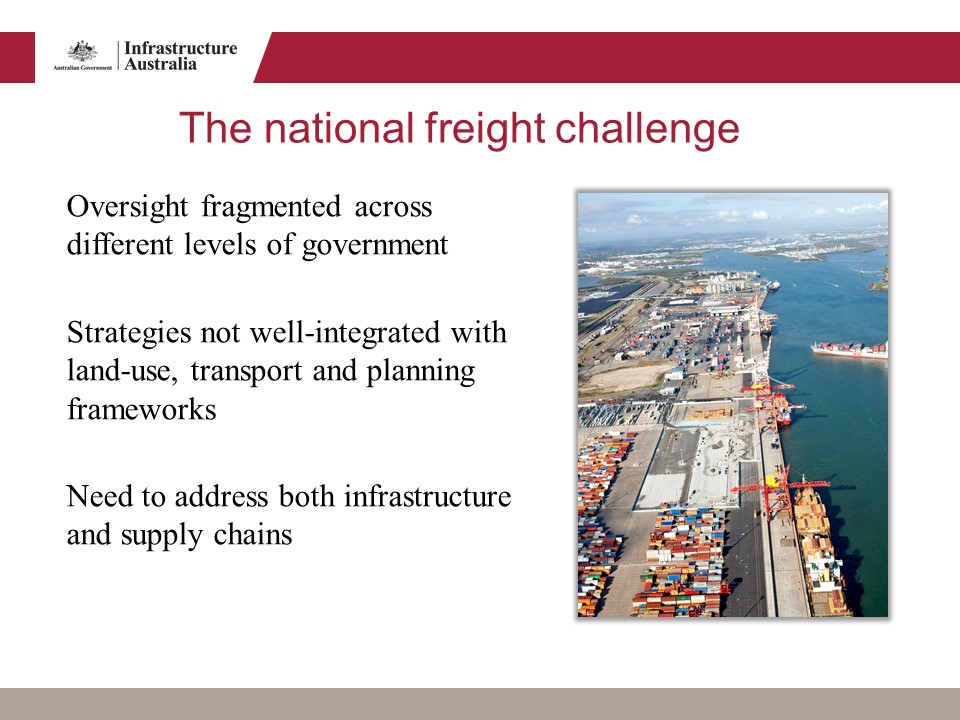
The national freight challenge
The Australian Infrastructure Plan identifies a range of challenges that need to be addressed if Australia's freight and supply chain networks are to meet this forecast growth in demand.
Chief among these challenges is that the ownership, operation and oversight of Australia's freight networks is fragmented across governments and private providers.
Currently, freight planning is being undertaken by all levels of government. But it is usually not well-integrated with other land-use, transport and strategic planning frameworks.
Many of these strategies also lack a wider national and international, freight and supply market perspective.
The current strategies tend to address infrastructure and individual modes rather than focusing on the supply-chains that are necessary for the freight sector to support Australia's economic development.
Most of these strategies have a short to medium term focus, while issues, such as freight movements within cities, are not addressed as well as they could be, particularly with significant population growth over the 15 years.
They have not kept pace with developments since they were initially formulated, both in terms of policy changes and the availability of new analytic tools which allow for a more detailed and sophisticated examination of supply chains.
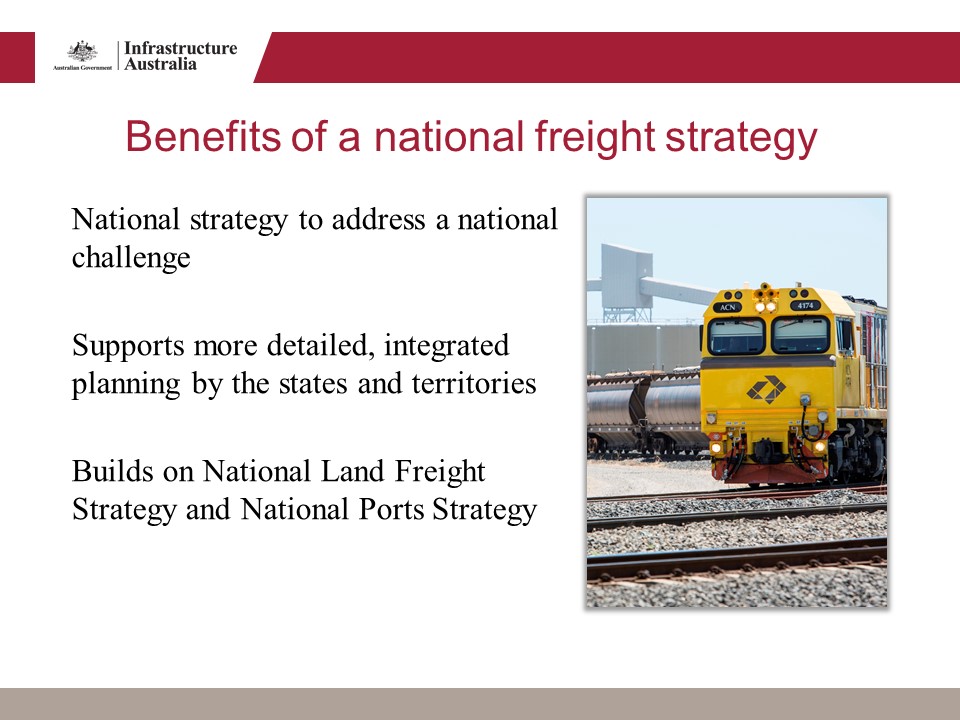
Benefits of a national freight strategy
Beyond the limitations of the current approaches, there are broader strategic benefits to be gained through a long-term National Freight and Supply Chain Strategy.
Given that many of the freight challenges we face are nationally-significant, for example—responding to increasing demand from our trade partners in Asia—the responses to these challenges need to be considered nationally.
Additionally, significant savings can be achieved by addressing issues on a collaborative basis, rather than each jurisdiction charting its own course.
A key recommendation in the Australian Infrastructure Plan, is therefore that a National Freight and Supply Chain Strategy be developed to guide investment and reform.
Building on the work already underway at federal, state and territory levels, as well as the National Land Freight Strategy and National Ports Strategy.
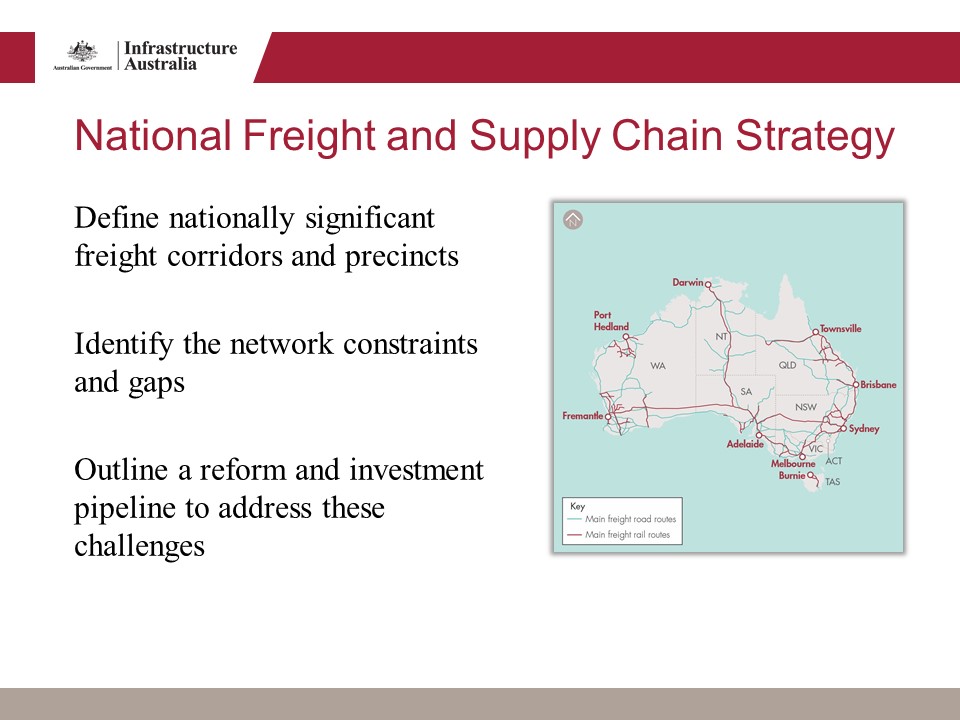
National Freight and Supply Chain Strategy
In our view, the strategy must be developed through a highly collaborative and consultative process and should:
- Define nationally significant freight corridors and precincts
- Identify the network constraints and gaps, and
- Outline a reform and investment pipeline to address these challenges.
Taking this approach, a National Freight and Supply Chain Strategy would also improve project development, as it would strengthen the ability of governments and Infrastructure Australia to assess the strategic context for investment proposals.
This is just one example of how long-term strategic infrastructure and land use planning can support better project selection and improve outcomes for infrastructure users.
Through the strategy, essential corridors could be identified now and protected for future freight routes and terminals.
Reforms and investments could be considered to support and enable more efficient freight movements through the network, and fund maintenance and renewal of existing infrastructure.
Establishing a sustainable source of funding for these kinds of maintenance works is another important piece of the puzzle.
And in the freight sector, there is no better opportunity to do so than by changing our approach to how we pay for roads.

A fairer, user-pays approach to road funding
A major overhaul of the way we fund our road networks is a key recommendation in the Plan, and it is a process which requires the strategic context provided by a National Freight and Supply Chain Strategy.
This is reflective of Infrastructure Australia's view that user charging should in most instances be considered first as a means of funding development, maintenance and operation of infrastructure assets.
Around the world, experience shows that infrastructure is best delivered under a user-pays structure in a well-functioning, well-regulated market.
The direct link between usage and supply delivers services that are efficient, responsive to consumer demands and financially-sustainable.
These market structures provide price signals to users that reflect the cost of supply, and communicate the demand profile back to infrastructure providers.
This is as true for Australia's ports as it is for our road networks. But while our ports are relatively self-sufficient, the same cannot be said of our roads.
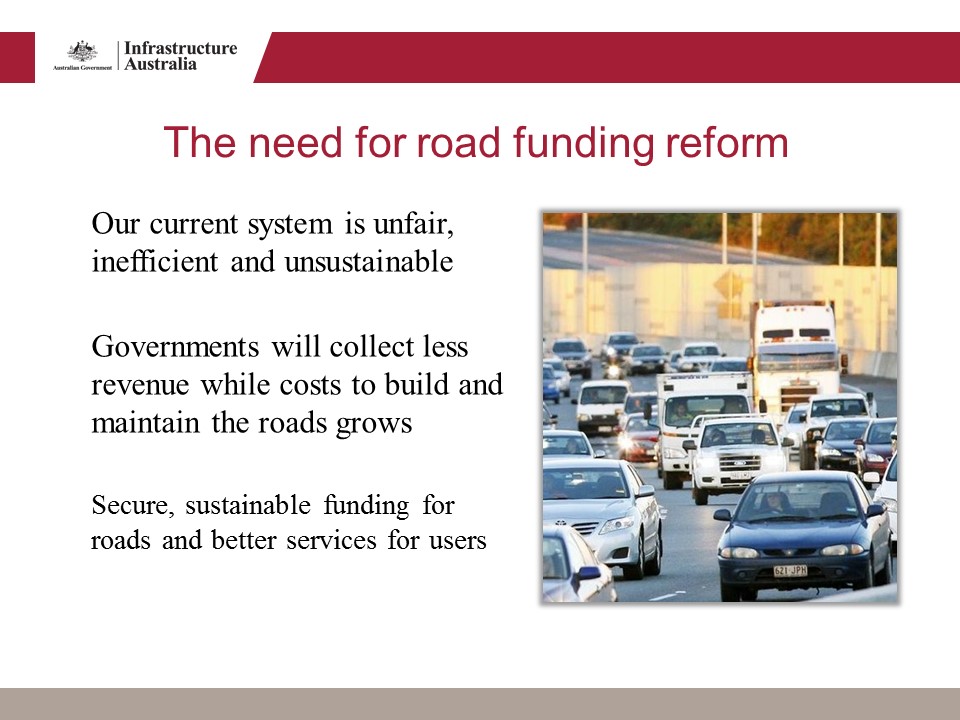
The need for road funding reform
Currently the taxpayer is directly involved in funding road infrastructure across its planning, delivery and operation.
This system is broken—it is unfair, inefficient and unsustainable and we should move to fix it within the next ten years.
This is primarily because the link between usage and charging in our current system of road funding is very weak.
What we pay is only loosely related to what we use and how our use of vehicles impacts other users, and this is particularly true of heavy vehicles.
Road users do not receive price signals to minimise their impact on other users and the broader network.
The result is a network which is chronically congested for portions of the day, but with excess capacity across most of the 24-hour cycle.
In addition to being unfair and inefficient, our current system of paying for our roads is simply unsustainable.
While funding for maintenance and development of our road networks is at the mercy of the annual budget cycles of governments, revenue collected from fuel excise is on the decline.
Today fuel excise raises less than half of what Australian governments of all levels spend on roads, and this fall in revenue will accelerate over coming decades as we shift towards more fuel efficient vehicles and alternate fuels.
This means we will be collecting less from users while the costs to build and maintain the roads continue to grow.
Given the freight challenge I have just outlined, the imperative for change is clear.
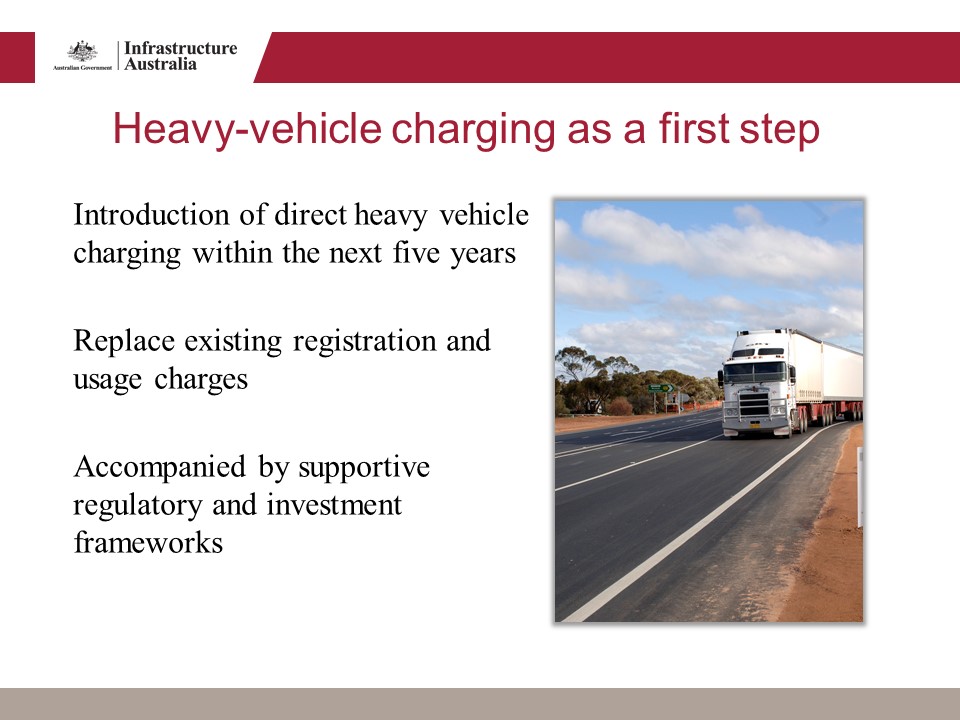
A fairer, user-pays approach
We need to transition to a fairer user pays approach that would allow charging to be linked to funding and supply to be linked to demand.
Under a fairer user pays system, fuel excise and registration fees would be replaced by road users only paying for the kilometres they travel on the roads they use.
Unlike the current approach where taxes and charges are allocated to various government spending priorities—both in transport and other areas, this revenue would be reinvested back into the transport network.
A user-pays system of road-funding could deliver secure, sustainable funding for our roads—and better services for users—but we need to get on the front foot and begin planning for this level of change sooner rather than later.
Heavy-vehicle charging
While the Plan recommends moving to direct user charging for all vehicles within 10 years, the introduction of direct heavy vehicle charging should occur within the next five years.
Ensuring heavy vehicles are charged for the true costs they impose on the broader road network is essential to increasing the competitiveness of Australia's freight networks.
This reform must include the removal of all existing registration and usage charges and the introduction of supporting regulatory and investment frameworks.
We must build on the substantial policy and research work that has already been done around the form and function of a reformed approach to heavy vehicle charging.
While these processes did not ultimately lead to implementation of a heavy vehicle charging regime, the body of work remains and is available to be drawn on—meaning a new approach would not need to begin from scratch.

Public inquiry into road reform
Even so, we recognise that changing how we pay for roads will not be easy. The existing structures are familiar and the reforms are complex, but the rewards are substantial.
That's why Infrastructure Australia has recommended that the Australian Government initiates a public inquiry into the existing funding framework for roads and the development of a fairer road user charging reform pathway.
The inquiry should be led by an independent body like Infrastructure Australia and consider:
- Flaws in the existing charging framework—including fairness, financial sustainability and economic efficiency;
- The optimal approach for road user charging and transport infrastructure funding in Australia;
- The social implications of charging reform, including transitional and distributional impacts of replacing current taxation with direct user charges; and
- A detailed reform pathway for transition to a full user pays model for roads.
Once both industry and the community understand the limitations of the current system, we can then begin to think about how a user pays system of road funding would work in practice.
Conclusion
The demand for more efficient import, export and movement of freight within Australia is certainly there.
But it's time for Australia to ensure its networks are better equipped to supply this growing demand.
This means better infrastructure planning, through the development of a National Freight and Supply Chain Strategy.
And better infrastructure delivery, through the establishment of a sustainable system of funding our road networks.
If Australia can get this right, we will all secure the social and economic benefits that come from great infrastructure.
Thank you for listening.

